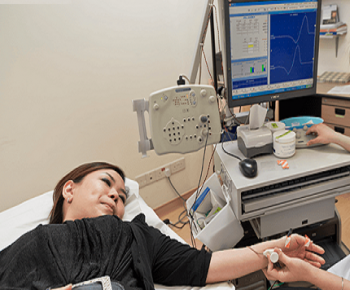Best Facilities Services At Your DoorStep
EMG
Price : INR 4000/-
What is an electromyography?
Electromyography (EMG) measures muscle response or electrical activity in response to a nerve’s stimulation of your muscle. The test is used to help detect nerve and muscle problems.
During the test, your doctor will insert one or more small needles (also called electrodes) through your skin into your muscle. The electrical activity picked up by the electrodes is then displayed on a monitor in the form of waves. An audio-amplifier is used so the activity can be heard.
EMG measures the electrical activity of your muscle during rest, slight contraction, and forceful contraction. Muscle tissue does not normally make electrical signals during rest. When an electrode is inserted, a brief period of activity can be seen, but after that, no signal should be present.

After all of the electrodes have been inserted, you may be asked to contract your muscle, for example, by lifting or bending your leg. The action potential (size and shape of the wave) that this creates on the monitor give information about the ability of your muscle to respond to nerve stimulation. As your contract your muscle more forcefully, more and more muscle fibers are activated, producing action potentials.
A healthy muscle will show no electrical activity (no signs of action potential) during rest, only when it contracts. However, if your muscle is damaged or has lost input from nerves, it may have electrical activity during rest. When it contracts, its electrical activity may produce abnormal patterns.
An abnormal EMG result may be a sign of a variety of muscle or nerve disorders, including:
- Polymyositis (an inflammatory muscle disease that causes decreased muscle power)
- Muscular dystrophy (a chronic genetic disease that progressively affects muscle function)
- Myasthenia gravis (a genetic or immune disorder that occurs at the point where the nerve connects with the muscle)
- Myotonic (stiff) muscles
A related test that may be done is a nerve conduction velocity (NCV) test. This is also called a nerve conduction study (NCS). NCV is a measurement of the speed of conduction of an electrical impulse through a nerve. NCV can determine nerve damage and destruction, and is often done at the same time as EMG. Both tests help detect the presence, location, and extent of diseases that damage the nerves and muscles.
Why might I need an EMG?
EMG is often used along with nerve conduction velocity (NCV) to tell the difference between a muscle problem and a nerve problem. NCV detects a problem with the nerve, whereas EMG can detect a problem with the muscle.
EMG may be done to find the cause of symptoms, such as muscle weakness, deformity, stiffness, and shrinkage. It may be used to detect whether someone is having true muscle weakness or weakness because of pain or psychological reasons.
EMG may be used to evaluate many problems or disorders, including:
- Neuromuscular diseases, such as myasthenia gravis
- Motor problems, such as involuntary muscle twitching
- Nerve compression or injury, such as carpal tunnel syndrome
- ANerv_20140108_v0_001
- Nerve root injury, such as sciatica
- Muscle degeneration, such as muscular dystrophy
HumanCare Path Labs: Your Trusted Partner in Healthcare and Diagnostics
Experience Precision and Care
At HumanCare Path Labs, we are committed to providing accurate and timely diagnostic services to our patients in Delhi and NCR. With state-of-the-art technology and a team of highly skilled professionals, we offer a comprehensive range of diagnostic tests to cater to your diverse healthcare needs.
Why Choose HumanCare Path Labs?
- State-of-the-Art Technology: We utilize the latest diagnostic equipment to ensure accurate and reliable results.
- Expert Team: Our experienced pathologists and technicians are dedicated to delivering the highest quality care.
- Convenient Locations: Our multiple clinics across Delhi and NCR make it easy to access our services.
- Quick Turnaround Time: We prioritize timely results to help you make informed decisions about your health.
- Patient-Centric Approach: We are committed to providing a comfortable and hassle-free experience for all our patients.
Our Range of Services
HumanCare Path Labs offers a wide range of diagnostic services, including:
- Blood Tests: Comprehensive blood tests to assess overall health, including blood sugar tests, cholesterol tests, liver function tests, kidney function tests, and more.
- ECG: Electrocardiogram (ECG) tests to diagnose heart conditions and abnormalities.
- MRI Scans: Magnetic Resonance Imaging (MRI) scans for detailed imaging of internal organs and tissues.
- PET Scans: Positron Emission Tomography (PET) scans for detecting cancer and other diseases.
- Holter Monitoring: Continuous monitoring of heart rhythm over 24 hours.
- NCV Tests: Nerve Conduction Velocity tests to assess nerve health.
- 24-Hour Blood Pressure Monitoring: Continuous monitoring of blood pressure over 24 hours.
- EMG Tests: Electromyography tests to assess muscle health and nerve function.
- Sleep Studies: Polysomnography to diagnose sleep disorders like sleep apnea.
- EEG Tests: Electroencephalography to measure brain electrical activity.
- Pulmonary Function Tests: To assess lung function and diagnose respiratory conditions.
Why Regular Diagnostic Tests are Important
Regular diagnostic tests are crucial for maintaining good health. They can help detect potential health problems early, allowing for timely intervention and treatment. Some of the benefits of regular diagnostic tests include:
- Early Detection of Diseases: Regular check-ups can help detect diseases like cancer, diabetes, and heart disease in their early stages.
- Monitoring Chronic Conditions: For people with chronic conditions, regular tests can help monitor disease progression and adjust treatment plans as needed.
- Assessing Overall Health: Comprehensive blood tests can provide insights into overall health, including nutritional deficiencies, hormonal imbalances, and other underlying conditions.
- Peace of Mind: Knowing your health status can provide peace of mind and help you make informed decisions about your lifestyle and healthcare.
Book Your Appointment Today
To get your tests done, please fill out the form on contact page, call our front desk on below given numbers, or simple visit the center directly. Our friendly staff is ready to assist you with any questions or concerns you may have.
Visit Us
J-17, Lower Ground Floor, Kalindi Kunj Rd, Jamia Nagar, Okhla, New Delhi 110025
+91 62040 63485
+91 80762 50713
+911145665176
info@hcpathlabs.com
Opening Hours
Mon - Sat: 8:00 am - 6:00 pm Sundays: 8:00 am - 1:00 pm
